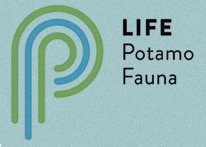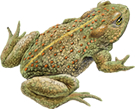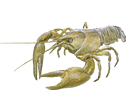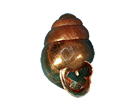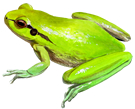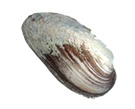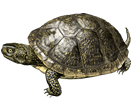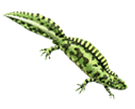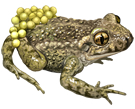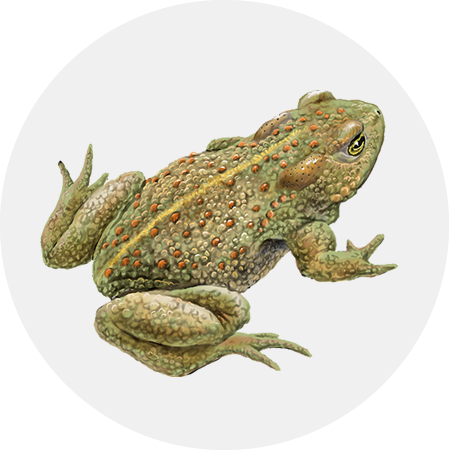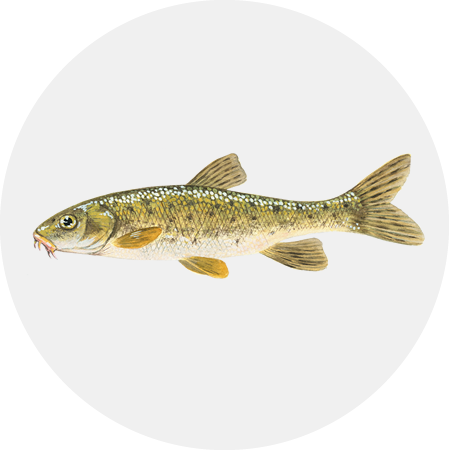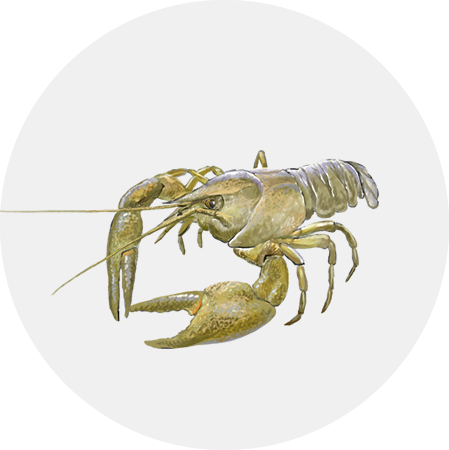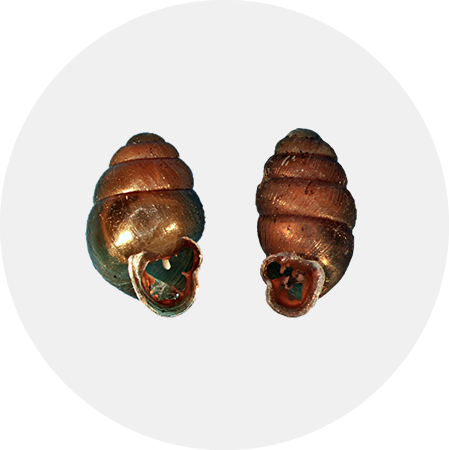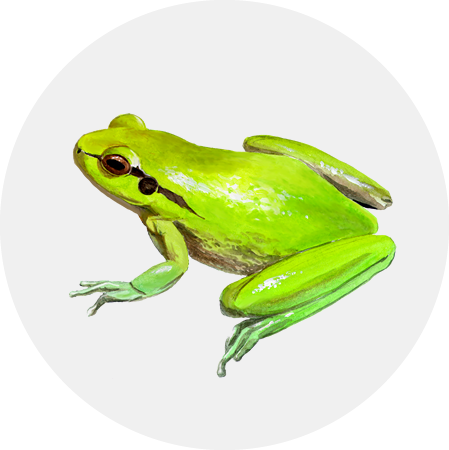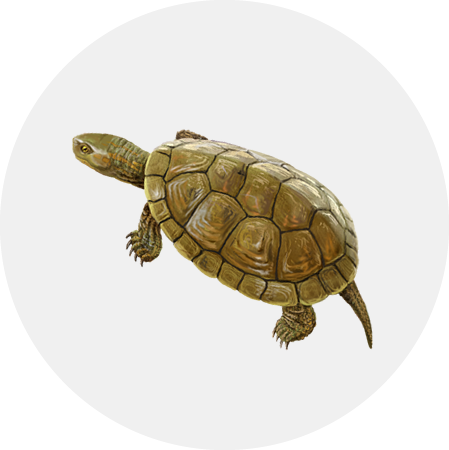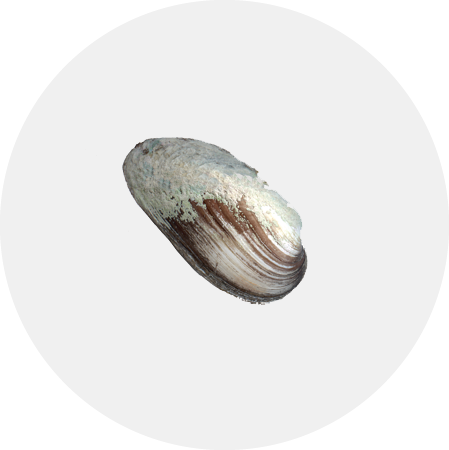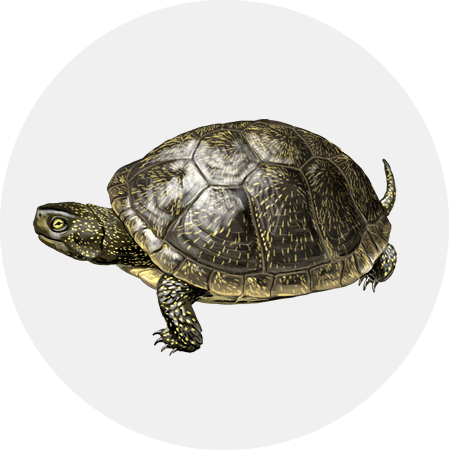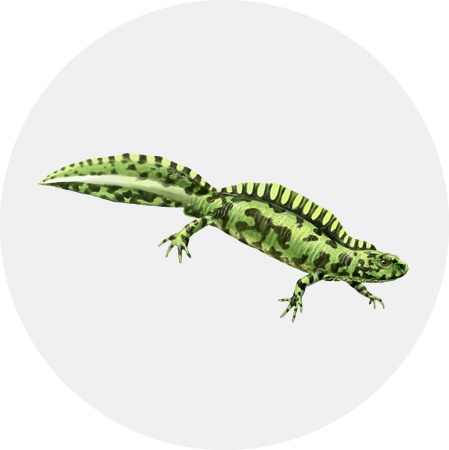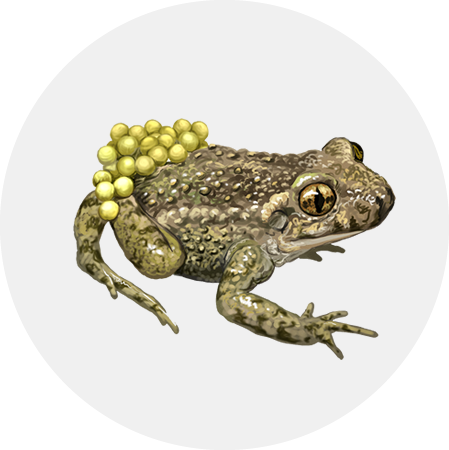Autochthonous species
Natterjack Toad (Bufo calamita)
The toad is a Palaearctic species found from the Iberian Peninsula to Belarus, Ukraine and southern Sweden. It is also found in the British Isles. This is an essentially land amphibious but it gets close to the water to mate and lay eggs.
This toad is robust and has a relatively short limbs. His head is wider than long, with short, rounded snout and prominent eyes with horizontal pupil and a yellow iris with black veins. The skin is rough and full of warts with colored spots (including green, brown and gray) and a yellow stripe that runs along the back. It’ss smaller than the common toad. Males are between 4 and 7 inches and females between 5 and 10 inches. It eats a lot of different kind of insects.
The toad is a protected species in Catalonia and has a good condition thanks to its adaptability to different environments associated with aquatic environments temporary ponds, fields and flood zones. However, it suffers from high mortality rates for road accidents and is a species in decline, also due to the disappearance of wetlands. It can be one of the new settlers in new environments and responds very well to restoration initiatives of temporary aquatic environments.
The actions of the LIFE Potamo Fauna to conserve the species are:
- Preparation of projects executed by the recovery of small wetlands and ponds in Low Ter basin.
- Recovery of micro Lower Ter wetlands as habitat for the species.
- Monitoring amphibian populations in small wetlands of the River Ter.
- Tasks outreach organization of press conferences, publication of informational materials, posters and lectures project, among others.
Mediterranean Barbel (Barbus meridionalis)
The Mediterranean Barbel is only found in the Mediterranean area of southern France and north-east of Catalonia. This fish is abundant in rivers and mountain streams for all kinds of water, although it is also found in low and middle sections of some Mediterranean rivers.
The color of his body is between brown and gray with black spots, and short whiskers stand on his small head. It is a freshwater fish of the family of cyprinids such as carp and catfish, but relatively small-sized. Females are up to 30 inches and males up to 25 inches. The maximum weight is 500 grams. Their diet is based on aquatic invertebrates that live among rocks and seaweed.
It is a fish that has been always caught in Catalonia. Currently, however, it can only be caught without death, because it is in decline in many places by the poor state of water, habitat degradation and the introduction of exotic species.
Actions in LIFE Potamo Fauna to conserve the species are:
- Drafting of protocols for reinforcements population of Mediterranean Barbel fish and other naiad guests.
- Reinforcements Mediterranean Barbel population of fish and other naiad guests.
- Monitoring Mediterranean Barbel and other fish populations.
- Monitoring of the ecological and water quality.
- Tasks outreach organization of press conferences, publication of informational materials, posters project talks.
White-clawed Crayfish (Austropotamobius pallipes)
This crayfish was in much of central and northern Europe. Today has been relegated to some small sections header rivers and streams. It prefers calm waters, clean, clear and oxygenated.
The color ranges from reddish brown to dark brown-green tones. It has a long cylindrical body, 8 to 9 inches, but can reach 12 weighs between 25 and 60 grams. It has five pairs of legs, two pairs of antennae and prominent eyes. The males have larger claws than females. Makes a setting of 50 to 100 eggs once a year.
The crayfish is omnivorous. Eats snails, insects, tadpoles and aquatic plants.
His condition is very worrying for the penetration of a deadly infection, the afanomicosi transmitted by several American invaders crabs. The white legs of crayfish is threatened throughout its range and is considered endangered in Catalonia.
The actions of the LIFE Potamo Fauna to conserve the species are:
- Drafting of protocols for breeding, the population reinforcements and protection against afanomicosi.
- Experimentation with the afanomicosi populations of crayfish.
- Reproduction of captive White-clawed Crayfish.
- Reinforcements population of White-clawed Crayfish.
- Protection against afanomicosi populations of White-clawed Crayfish.
- Control of exotic decapods.
- Monitoring White-clawed Crayfish populations and exotic decapod populations.
- Other tasks through the publication of informational materials, organization of press conferences and a conference on European freshwater decapod crustaceans, among others.
Wnorl Snail (Vertigo moulinsiana and Vertigo angustior)
These small snails (Vertigo moulinsiana and Vertigo angustior) have a Mediterranean-Atlantic distribution, from Ireland to the south and from Russia to North Africa, without being too common organisms anywhere. They are very scarce in the Iberian Peninsula, where they are considered critically endangered. The last major populations are known in BanyolesLake, living on the margins of permanent ponds and wetland areas without major oscillations.
These gastropods have a shell that is colored brown to yellowish, translucent and shiny. The body and the horns are almost black. They have a very small size, about 2 thousand mm in adults. It is hermaphroditic species that frequently reproduce by selfing.
They feed on microorganisms that grow on the leaves of marsh vegetation.
The main threats to the species are changing hydrology, eutrophication and pollution, fragmentation and habitat destruction.
The actions of the LIFE-Potamo Fauna to conserve the species are:
- Writing a protocol for reinforcements population of both Vertigo moulinsiana and Vertigo angustior in Banyoles.
- Reinforcements population of both Vertigo moulinsiana and Vertigo angustior in Banyoles.
- Monitoring both Vertigo moulinsiana and Vertigo angustior populations.
- Tasks disclosure of information material editing, organizing press conferences or talks, among others.
Mediterranean Tree Frog (Hyla meridionalis)
The tree frog is distributed to several countries in the Palearctic region: Morocco, Algeria and Tunisia in the northeast of Africa; Portugal, Spain, southern and south-eastern France, north-east of Italy and Europe; and Madeira, the Canary Islands and the Balearic Islands (Minorca). The tree frog lives in aquatic environments with good vegetation cover. Throughout the reproductive period remains near water bodies, hidden in the bushes, or other formations in water shores. Their breeding habitats are temporary ponds, which is one of the more generalist species, including a wide gradient of habitats both in timing and in extension.
The back is yellowish green, sometimes with black specks. The underparts are whitish. The head is broad and the snout is short and rounded. The eyes are prominent and gold, the pupil is horizontal and elliptical. His skin is smooth except at the throat, where it is located the vocal tools and the stomach, where it is granulated. The units measure about 32 mm
The tree frog hunts on the lookout during the day and is also active at night. It feeds on crickets and Tenebrionidae larvae, among others.
In Catalonia is the most abundant of the frogs and is common in the Nature 2000 Network banks of the Lower Ter River (ES5120011) and Llémena River (ES5120020), and the species level generally does not present serious problems of conservation in the north-eastern Iberian which will develop the project. Together with the Green Frog (Pelophylax perezi) is the most abundant, especially easy to detect because of its striking song, and covers all areas of permanent and semi-permanent water with good vegetation cover such as pools, ponds irrigation, ponds, ditches, slow course, etc.. Is present in the areas of irrigation and orchard near the course of the river Ter Llémena. Their densities are especially high in the stretch of the River Ter populations of St. Gregory and Salt, and the confluence with the river Llémena where some almost permanent ponds and some orchards are very favorable areas for it.
The actions of the LIFE Potamo Fauna to conserve the species are::
- Drafting of executive projects for the recovery of micro Ter wetlands.
- Recovery of micro wetlands riverbanks of the River Ter.
- Monitoring amphibian micro wetlands of the River Ter.
- Monitoring of vegetation and limnological micro wetlands of the River Ter.
- Tasks outreach organization of press conferences, publication of informational materials, lectures.
Mediterranean Turtle (Mauremys leprosa)
This turtle is found in the Iberian Peninsula, North Africa and some parts of southern France. It lives in freshwater inland aquatic environments, like streams, ponds, lakes, reservoirs and coastal lagoons, avoiding large rivers.
Is a turtle with oval shell, flattened, and brown-green colour. The neck has narrow orange or yellowish strips, especially in juveniles. It is about 25 inches from head to tail.
This turtle is carnivorous. It feeds on invertebrates, amphibian larvae, small fish and some vegetables. Just out of the water for sunbathing. They hibernate in late fall to early spring, when they begin the breeding period.
It is an endangered and protected species because of habitat degradation (drying, use changes, overexploitation of water) and competition from introduced species such as the Florida Turtle. However, it is in expansion in the northeast of Catalonia, and therefore must conserve and enhance habitats to consolidate current populations.
The actions of the LIFE Potamo Fauna to conserve the species are:
- Drafting of executive projects for the recovery of small wetlands in Ter river.
- Recovery of small wetlands in Ter river basin.
- Control of invasive exotic turtles.
- Monitoring pond turtle populations.
- Tasks outreach editing promotional materials, organization of seminars and press conferences, among others.
Naiad (Unio elongatulus, Unio mancus, Unio ravoisieri)
The naiad is an elongated freshwater mussel that is distributed to the Iberian Peninsula and probably some French Mediterranean rivers. Iberian populations correspond to the species Unio mancus and Unio ravoisieri. The Naiad live half buried in the sand and gravel from the bottom of rivers and lakes in areas with little current, but also can be found in canals and ditches that carry water throughout the year.
Its color is usually dark black tones, yellow and green. They can take up to 12 centimeters long. The larvae parasitize fish -mainly for Barbels and similar species-, metamorphosis into juvenile and thus grow.
These animals are filter feeders that feed on particulate matter, plankton and detritus. So what they do is to clean and filter the water. In Catalan, its common name means “fairy”, responsible for maintaining the purity of the water.
Its conservation status is vulnerable because their populations are in decline everywhere, so that, are protected species. The decline of native fish, habitat destruction, introduction of exotic fish species and water pollution have made many stretches of river disappeared.
The actions of the LIFE Potamo Fauna to conserve the species are:
- Drafting of protocols for captive breeding population of naiad and reinforcements.
- Writing a protocol for reinforcements population of Mediterranean Barbel fish and other naiad guests.
- Reproduction and of Mediterranean Barbel population of fish and other naiad guests.
- Monitoring naiad populations.
- Tracking Mediterranean Barbel fish and other naiad guests naiad and exotic fish.
- Tasks of disclosure of information material editing, organizing press conferences and participation in public events, among others.
European Pond Turtle (Emys orbicularis)
The pond turtle is a water turtle native to Europe, Asia and northwestern Africa. It covers all types of bodies of water: permanent ponds, temporary ditches, some reservoirs, rivers and streams, preferring those with little or no running water and abundant vegetation cover.
It is a turtle shell with a rounded, dark lines and yellow spots. The head has also dark spots and yellow spots. The average size of an adult is about 15 inches and weighs between 250 and 300 grams Females are usually larger than males.
This reptile feeds on invertebrates, amphibian larvae, small fish and vegetables. The pond turtle hibernates from late autumn to early spring, when the breeding season begins.
In Catalonia is declining because of the worrying degradation of habitat and competition from introduced species such as the Florida turtle. In the Girona presents isolated populations, especially in La Selva (Sils Lake and Riudarenes), the Ter basin, Empordà Marshes and Banyoles Lake, and recovery along the Ter River, where there are few observations, where is a very important place for the future conservation of the species.
The actions of the LIFE Potamo Fauna to conserve the species are:
- Drafting of protocols for captive breeding population of reinforcements and pond turtles.
- Recovery of small wetlands in the Lower Ter riverbanks as a habitat for the species.
- Captive Breeding of pond turtles in the Breeding Centre of Albera and making reinforcements in riverbanks of the River Ter and Banyoles Lake.
- Control of invasive exotic turtles.
- Monitoring pond turtle populations.
- Tasks that outreach editing promotional materials, organization of press conferences, lectures and organizing a national conference on scientific and technical river fauna threatened, among others.
Western Spadefoot Toad (Pelobates cultripes)
The distribution of Western Spadefoot Toad is virtually restricted to the Mediterranean area of the Iberian Peninsula, entering the southeastern coast of France to the foothills of the Maritime Alps and appearing singly on the French Atlantic coast. The Western Spadefoot Toad live in areas not compacted or in sandy substrate that allows to bury without difficulty. It reproduces both natural and artificial environments, both permanent and temporary. However, in temporary environments, their prolonged larval development, means that there is significant mortality of tadpoles in short periods of flooding.
Its dorsal coloration is variable, whitish, yellowish, grayish, greenish or brown, often with the presence of brown spots or dark green. Tones presented ventrally are whitish or yellowish gray, sometimes with dark spots. This frog looks robust and is medium size. The maximum total length is between 119 mm and 125 mm three-in females collected in the province of Seville-although generally have smaller sizes, the females being larger than males. The head is wider than long, with large protruding eyes. The skin is smooth and shiny. This frog eats a variety of invertebrates including gastropods, Orthopteraand Coleoptera. Individuals can capture small or even large amphibians.
In Catalonia is an extremely rare species in the area, with only one known population, very small and located in an area of fluvial sands around the Salt River Ter, right in the area of confluence with Llémena. This situation severely limits the recovery of the species.
The actions of the LIFE Potamo Fauna to conserve the species are:
- Drafting of executive projects for the recovery of micro Ter wetlands.
- Recovery of micro wetlands riverbanks of the River Ter.
- Monitoring amphibian micro wetlands of the River Ter.
- Monitoring of vegetation and limnological micro wetlands of the River Ter.
- Tasks outreach organization of press conferences, publication of informational materials, lectures.
Marbled Newt (Triturus marmoratus)
The Marbled Newt has a western European distribution, and is localized in many parts of France and the northern half of the Iberian Peninsula. It has a kind ability to deal with all types of aquatic environments, both permanent and temporary in different sizes, whether small ponds and lakes, or rivers and streams, but not loitering current major waterways. It is much more abundant in water bodies with abundant aquatic vegetation and wetlands preferings temporary or permanent, but with a significant volume of water.
The color of its body is green or yellow-green with numerous blackish spots forming a large size and often cross-linked together forming large bands. The eyes are prominent and located in the lateral position. The body is sturdy and with subcircular section, slightly flattened dorso-ventrally. The tail has a length slightly less than the body, but can represent 50% of the body length. Marbled Newt is a medium-sized, adults measuring between 120 and 140 mm -the females are slightly larger, are between 115 and 149 mm-. Only exceptionally reach 160 thousand mm.
Like most newts Iberian Marbled Newt presents the annual cycle combined with a phase of terrestrial and aquatic form. In the phase of terrestrial gastropods fed on larvae, butterflies, small insects and worms; during the quatic phase feeds on crustaceans, larvae of Diptera, and Efemeroptera.
In Catalonia is the most delicate of the Marbled Newts in the areas Nature 2000 Network banks of the Lower Ter River (ES5120011) and Llémena River (ES5120020). However this is kind of fragmented and occasionally in Mediterranean streams, ponds and agroforestry areas situated around the middle stretch of the river Ter outside the area included in the Natura 2000 network. The of ponds of semi permanent water in flooding areas around the river sections is one of the main threats due to denaturation of the riverbanks, and also because of the presence of crawfish.
The actions of the LIFE Potamo Fauna to conserve the species are:
- Drafting of executive projects for the recovery of micro Ter wetlands.
- Recovery of micro wetlands riverbanks of the River Ter.
- Monitoring amphibian micro wetlands of the River Ter.
- Monitoring of vegetation and limnological micro wetlands of the River Ter.
- Tasks outreach organization of press conferences, publication of informational materials, lectures.
Common Midwife Toad (Alytes obstetricans)
The Common Midwife Toad is founded from West Germany, a small part of the Netherlands, northern Switzerland, southern Belgium, Luxembourg, France to virtually all large part of the Iberian Peninsula. In the latter region is well distributed and can be considered abundant in the northern third, from Galicia to Catalonia, being scarce in Zaragoza and Huesca. The toad inhabits all types of bodies of water with little or no current. His long larval development affects its presence in ponds that have a long water period. In some parts of Catalonia the abundance of tadpoles of this species was positively correlated with water periode, sun exposure and wooded low coverage around the ponds.
This frog has a variable dorsal coloration, gray, brown or dark green similar to the color of the olives. Presents small green spots, reddish and black little marked and distributed more or less evenly. His skin is slightly grainy with small warts, its body is short and stubby, and its head is wide and large in relation to the body. It also has large eyes and prominent lateral arrangement. The males measure up to 52 mm and females up to 50 mm.
The toad feeds on terrestrial prey, mostly small arthropods, worms and molluscs.
The species is highly tolerant to environmental changes, even colonizing recently disturbed areas. The population of the Common Midwife Toad in areas Nature 2000 Network banks of the Lower Ter River (ES5120011) and Llémena River (ES5120020) is closely related to water points (ditches, canals, reservoirs...) environments around the agricultural river areas. This is considered common in the section of the river Ter area around Sant Gregori and Salt, where there are large areas of irrigated land and orchards, and agricultural areas around the municipalities in the Ter River such as Celrà, Bordils, Cervià de Ter, Sant Jordi Desvalls, Flaçà Colomers and Foixà.
The actions of the LIFE Potamo Fauna to conserve the species are:
- Drafting of executive projects for the recovery of micro Ter wetlands.
- Recovery of micro wetlands riverbanks of the River Ter.
- Monitoring amphibian micro wetlands of the River Ter.
- Monitoring of vegetation and limnological micro wetlands of the River Ter.
- Tasks outreach organization of press conferences, publication of informational materials, lectures.
